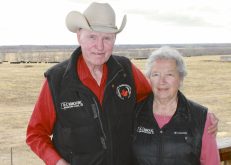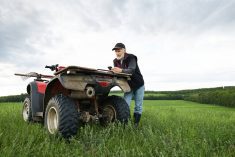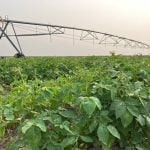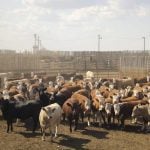With Canada’s farm population aging, it stands to reason transition planning would be a high priority for farmers in this country.
But that doesn’t appear to be the case. Despite 60 per cent of Canadian farmers being age 55 or older, fewer than one in 10 have a written transition plan, according to Farm Management Canada, a national resource centre for farmers — this despite an estimate that 75 per cent of farms could change hands over the next 10 years.
That needs to change, says Tim Lang, a business advisor with Farm Credit Canada (FCC), who spoke about farm transition planning at Manitoba Ag Days in Brandon in January.
Read Also

Made-in-Manitoba sunflower hybrid headed to market
Manitoba’s confection sunflower growers will have a new seed option next spring developed specifically for performance in the province. The…
One of the questions farm owners and operators need to ask themselves, he says, is whether the junior generation has a clear path to ownership and management of the family farm — or are they working based on a promise?
“There’s a lot of times we sit down with customers and there’s a lot of tension in the room because the junior generation might be in their 40s or 50s, they work on the farm and are labour, but they don’t own anything,” he says.
“They’ve been told at some point in the future they’re going to take over the farm, but at this point there’s no clear path as to how that’s going to be done and nothing’s been put down in writing. They’re basically working on a promise that at some point in the future it’s going to be theirs. (But) if something does suddenly happen and there’s no plan in place to reflect what those plans are, then we have a problem.”
One early step to undertake in transition planning is to assemble an advisory team to counsel a farm’s ownership group on how to properly navigate the process.
That team should include an accountant, a lawyer, a financial planner and an insurance agent. Lang says it’s also a good idea to include someone who can provide mental and physical health support.
“Our team at FCC, and our business advisors — we talk all the time about always utilizing your professional advisors,” he says.
“Get them engaged early in the process and ensure you are utilizing them to their full capability. They’re the ones with the professional expertise that are going to be able to guide you through this process.”
Take a meeting
Another important consideration in transition planning is to include family members in the discussion. Lang suggests families hold a series of transition meetings, during which each family members gets to voice any suggestions or concerns they have.
“Unspoken expectations are the silent killer of the family farm,” he says. “A lot of farms are really good at having operational meetings, but transitional meetings are the ones that are sometimes forgotten and that can lead to unsaid expectations.
“We encourage everyone to sit down as a family at the end of the year, jot down what went right and what went wrong and allow everyone to have a voice at the table. Ensuring everyone has a voice is very important.”
As part of those meetings, everyone’s roles and responsibilities in any transition plan should be clearly identified. That includes who will carry out specific tasks, who will provide time and labour to complete those tasks, who will be accountable for them being completed and who the ultimate decision-maker will be in that process.
“What it’s meant to do is identify any areas where there may be a lack of knowledge for the junior generation,” Lang says. “It can really identify who’s doing what and who should be more involved in certain aspects of the farm.”
As part of that process, families may want to consider drafting some form of a memorandum of understanding involving each family member. Not only will an MOU provide a written version of what family agreements have been decided upon, but it can also record why those decisions were made, for future reference.
“Working with family means everything is personal,” Lang says.
“Many times, what that means is things like formal agreements are sometimes avoided because we think nothing is going to happen and we don’t want to go through the cost and hassle of putting formal agreements in place because we’re family and everything’s going to be OK. It’s very important when decisions are made and you look back that you can figure out why we made those decisions.”
Following the process
Families may need to change their collective mindset regarding the transition of the family farm, Lang says. Rather than considering it an event, families should view it as a process.
As part of that process, he recommends families gather all relevant data about the farm prior to meeting with their advisory team. That includes preparing a farm asset list and making sure it’s up to date.
“Sometimes when we talk to a customer, what we find is they may say the corporation farms 20 quarters and it’s all owned by the corporation. But as we dig into it, we find maybe 10 quarters is owned by the corporation, five is owned by Dad personally and five are owned jointly by Mom and Dad,” he says.
“Ensuring those details are included can be very important when it comes to putting together a plan. If you have equipment that’s shared with a brother or the junior generation, it’s very important to note that.”
At the same time, the current owners may want to consider conducting a financial health check of their farm, in collaboration with their lender. This will provide a calculation of debt to net worth and provide an indication of whether the farm can be leveraged to pay out Mom and Dad or provide them with a retirement income.
“If it’s not in a position to do that, changes will need to be made or another plan will have to be determined,” Lang says.
It’s also a good idea at this point for the existing owners of the farm to dig out their current will and review it to make sure everything is in order prior to meeting with a lawyer.
If a family doesn’t have a will, FCC provides an online tool for will and estate planning that collects data and “spits out” a report card with ideas for what the family should focus on when they sit down with a lawyer.
“It’s amazing how many people don’t have wills. If it gets to a point where it’s too late, you can find yourself in a lot of trouble.”
Perhaps one of the most important considerations when planning for transition of the family farm is whether it should operate as a single profit centre or multiple profit centres.
A single profit centre is one in which Mom, Dad and children farm together as one corporation or partnership. In the case of multiple profit centres, each party has an entity essentially operated as a separate farm.
Both models have plusses and minuses, Lang says.
In the single profit centre model, everyone works together and the farm can be expanded even if the junior generation doesn’t have the resources to buy a complete line of equipment. The downside: a single profit centre means each party having to agree to work together, each member has limited financial independence and splitting up in the future can cause problems.
While multiple profit centres provide greater individual independence and freedom, that model can create additional economic tension and requires a far greater degree of communication between all parties involved.
Hidden costs
An important part of any transition planning, Lang says, is to accurately calculate how much it’s going to cost Mom and Dad to live when they are no longer involved in farm operations on a day-to-day basis.
That means not only calculating how much income the parents will need on an annual basis, but also how much the junior generation will need to budget to finance Mom and Dad’s retirement income.
As part of that exercise, both parties will need to review any so-called hidden costs of the parents that have previously been covered by the farm, including vehicles, fuel and utilities.
“Ensuring those are calculated into your budget is very important,” he said. “All those expenses need to be factored in now so you can ensure you have enough income for retirement at that point.”

Fairness
Of course, one of the most difficult parts of transition planning for most farm families is devising a plan that is fair for everyone, including both on- and off-farm family members.
That’s why it’s imperative for all family members to be involved in the process and to have an opportunity to express views throughout that process, Lang says.
Everyone involved must remember farming is an asset-based equity business rather than an income-based business most of the time, he says — meaning there are significant capital requirements, and debt to acquire that capital.
“Everybody’s thoughts on (what’s fair) are different. It’s just a matter of trying to determine in your particular situation what makes sense,” he says. “There is no right or wrong answer to this question. It’s going to take in a lot of factors. One is obviously what the farm can afford. Secondly, it’s what you feel comfortable with in your situation.”
Rainy-day fund
The natural inclination for many farmers during the good times is to reinvest any surplus funds they may have back into the farm. While there is merit to that kind of thinking, Lang suggests the senior generation also consider investing some of the money into a tax-free savings account (TFSA) or RRSPs for when the transition plan takes effect.
“Down the road this can really help to alleviate whatever the farm is going to have to pay to the off-farm kids or the parents in retirement,” he said.
What time is the right time?
So, when is the right time to transfer the farm to the junior generation? Truthfully, there is no one right answer. Lang said it depends largely on the family and its individual members’ wishes or circumstances.
One factor to consider is divorce. If a senior generation transfers land proactively to a child who subsequently divorces their partner, that partner could then be entitled to half the land, which may not be what the parents want. Conversely, if Mom and Dad get divorced prior to a child inheriting farmland, one of the parents could decide they no longer want to pass that land down as part of any transition plan.
Parents should also consider the possibility of what could happen once farm property becomes the sole domain of their offspring, Lang says. In most cases, there is nothing to prevent them from selling the land a year down the road and investing the proceeds in something else.
Relinquishing control
Perhaps no part of transition management can be more difficult for the senior generation than relinquishing control of some aspects of the day-to-day operations of the farm. While it can be a stressful time, Lang says it needs to be addressed.
“At some point in the future, you’ve got to start getting that junior generation more involved in the management of the farm,” Lang says.
“That can cause some stress and hard times sometimes because it’s tough to sit back and let someone else make some of the decisions on the farm, but that’s something that needs to be done.”
















